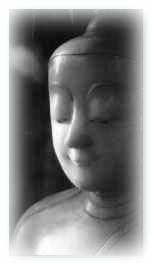Meditation Is in the Gap
“Be aware of your mental processes, how your mind works. The moment you become aware of the functioning of your mind, you are not the mind. The very awareness means that you are beyond: aloof, a witness. And the more aware you become, the more you will be able to see the gaps between the experience and the words. Gaps are there, but you are so unaware that they are never seen. Between two words there is always a gap, however imperceptible, however small. Otherwise the two words cannot remain two; they will become one.
“Between two words there is always a gap, howsoever in perceivable, howsoever small, but the gap is there. Between two notes of music there is silence, howsoever inperseivable. Otherwise tow notes cannot be two; two words cannot be two without the interval – a wordless interval is always there. But one has to be keenly aware, attentive, to know the gap, the interval.
“The more you become aware, the slower the mind goes. It is always relative. The less aware you are, the faster the mind is; the more aware you are, the slower the process of the mind is. With all things…but because you have become aware, it looks slower, it appears slower; it is the same. But you are keen, you are observing, you have become more conscious. More consciousness means a slower mind. When mind is slower, gaps widen; you can perceive them.
“It is just like a film. When a projector is run slowy, you see the gaps. There are so many gaps – gaps and gaps and gaps. If I raise my hand, it cannot be filmed without gaps. I can raise it without gaps, but it cannot be filmed without gaps. My hand raised, one foot raised, will have to be shot in a thousand parts and each part will be a still, dead photograph. These thousand parts, part-photographs – partial, dead – if they can be passed before your eyes so fast that you cannot see the gap, then you see the hand raised. Then you see the hand raised in a process because the gaps are not seen. Otherwise, films can never be taken without gaps. The gaps are there.
“Mind, too, is just like a projector, a linguistic projector. Gaps are there. Be more aware and attentive of your mind, and you will see the gaps. It is just like a gestalt picture. A picture can be made which can be seen as two things, but you cannot see the two things simultaneously. The picture can be of an old lady, and the same picture can be of a younger one. Both are in the picture but if you see one, you will not see the other because the attention changes. You are focused on one, then the other is not seen. When you see the other, the previous one is lost. Now you know that the same dots, the same inkblot, has two pictures. Now you know perfectly well, you have seen both, but you cannot see both simultaneously. Still, you cannot see both simultaneously. If you see the old lady, the younger is not seen. And you will even have some difficulty to change from one picture to another, because the focus becomes focused. You know – now you have seen the other picture also – but you will have some difficulty to change the focus. When the focus is changed the younger lady will be seen, but the older one will be lost.
“The same thing happens with the mind also. It is a gestalt. If you see the words, you cannot see the gaps. If you see the gaps, you cannot see the words. But now you know: there are words and there are gaps, and every word is followed by a gap and every gap is followed by a word, but you cannot see both simultaneously. If you are focused on the gap, words will be lost and you will be thrown into meditation. Words will not be there. The gap!
“These words and these gaps, these are two things in the mind. Mind is divided into two things – gaps and words – but every word follows a gap and every gap follows a word. The division is in a series; the mind is not divided into two watertight compartments – words and gaps. They are mixed. They are in a chain. Two words are being connected through a gap, and two gaps are being connected through a word.
“Mind focused, consciousness focused, only on words is non-meditative. Consciousness focused only on gaps is meditative. So meditation is a “gestalt attention” – attention, awareness, consciousness of the gaps. And you cannot be simultaneously aware of both, that is impossible. So, whenever you become aware, words will be lost. When you observe keenly, you will not find words; you will find only the gap.
“Not even “gaps” because you can feel the difference between two words, but you cannot feel the difference between two gaps. So words are always plural and gap is always singular: the gap. That’s why I use “the gap.” Words can be many; gaps cannot be. They become one. They trespass and they become one. So meditation to me means focusing on the gap.”
Osho, The Psychology of the Esoteric, Talk #2
To continue reading – and see all the available formats of this talk: click here



